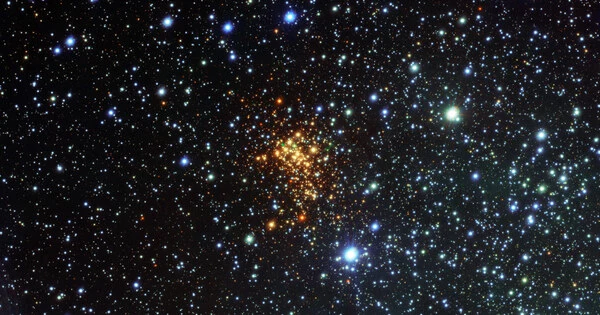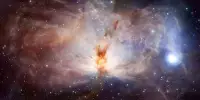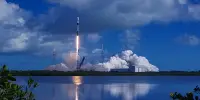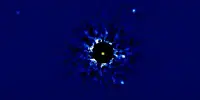At least three galaxy clusters are currently colliding spectacularly, as seen by astronomers. Astronomers are using data from the Chandra X-ray Observatory of NASA, the XMM-Newton of the European Space Agency, and three radio telescopes to make sense of this chaotic spectacle. These kinds of collisions and mergers are the primary mechanisms by which galaxy clusters might expand into the enormous cosmic structures we observe today. They serve as the biggest particle accelerators known to exist.
Abell 2256, a massive galaxy cluster that is developing as a result of this collision, is situated 780 million light-years from Earth. This composite image of Abell 2256 combines radio data from the Giant Metrewave Radio Telescope (GMRT), the Low Frequency Array (LOFAR), and the Karl G. Jansky Very Large Array (VLA) in red with X-rays from Chandra and XMM in blue, as well as optical and infrared data from Pan-STARRs in white and pale yellow.

Astronomers investigating this item are attempting to decipher the origin of this peculiar-appearing structure. The story is told differently via each telescope. Some of the largest objects in the universe are galaxy clusters, which comprise hundreds or even thousands of individual galaxies. They also have vast gas reserves that are extremely hot, with temperatures reaching several million degrees Fahrenheit. This heated gas can only be seen by X-ray telescopes like Chandra and XMM. The third galaxy cluster’s gas is too mingled with the other two to be distinguished in the labeled version of the graphic.
This system’s radio emission comes from a more intricate combination of sources. The first is the galaxies themselves, whose supermassive black holes at their centers produce the radio signal by ejecting particles into space-time in jets. These jets are either slowed down as they interact with the gas they are running into, forming intricate shapes and filaments (“A,” “B,” and “F”), or they are flying into space in straight, narrow lines (those named “C” and “I” in the annotated image, using the astronomer’s naming method). Three sources are present in Source F, all of which were produced as a result of a black hole in a galaxy aligning with the middle source of this trio.
Large filamentary formations (dubbed “relic”), largely found to the north of the radio-emitting galaxies, are also producing radio waves. These structures were probably produced when the collision accelerated particles in the gas over a distance of nearly two million light-years. The Astrophysical Journal’s March 2022 issue contains a research by Kamlesh Rajpurohit from the University of Bologna in Italy that examines this structure. The paper is online and was released earlier this year. This paper is the first in a series that examines many facets of this galaxy cluster system that is colliding.
Finally, a “halo” of radio emission can be seen close to the collision’s core. Another radio image has been created to highlight the weak radio emission since this halo overlaps the X-ray emission and is fainter than the filamentary structure and the galaxies. A model for how the halo emission might be caused by the reacceleration of particles due to rapid changes in the temperature and density of the gas as the collision and merging of the clusters progress is presented in Paper II, led by Rajpurohit, which was recently published in the journal Astronomy and Astrophysics and is available online. The fact that this model cannot fully describe all of the radio data’s characteristics emphasizes the necessity for additional theoretical research on this and related topics.
Rajpurohit and colleagues’ Paper III will investigate the radio-emitting galaxies in Abell 2256. These galaxies are unusually abundant in this cluster, maybe as a result of the merger and collision that are fueling the expansion of supermassive black holes and their ensuing eruptions. Erik Osinga will publish more information regarding the LOFAR image of Abell 2256 in a future paper.
The full list of co-authors for papers I and II include researchers from the University of Bologna, Italy (Franco Vazza, Annalisa Bonafede, Andrea Botteon, Christopher J. Riseley, Paola Domínguez-Fernández, Chiara Stuardi, and Daniele Dallacasa); Leiden Observatory, Leiden University, the Netherlands (Erik Osinga, Reinout J. van Weeren, Timothy Shimwell, Huub Röttgering, and George Miley); Thüringer Landessternwarte, Tautenburg, Germany (Matthias Hoeft and Alexander Drabent); INAF-Istituto di Radio Astronomia, Bologna, Italy (Gianfranco Brunetti and Rossella Cassano); Hamburger Sternwarte, Germany (Denis Wittor, Marcus Brüggen, and Francesco de Gasperin); Osservatorio di Astrofisica e Scienza dello Spazio di Bologna, Italy (Marisa Brienza); Center for Astrophysics, Harvard | Smithsonian (William Forman); Molecular Foundry, Lawrence Berkeley National Laboratory, Berkeley (Sangeeta Rajpurohit); Physical Research Laboratory, Ahmedabad, India (Arvind Singh Rajpurohit); Universität Würzburg, Würzburg, Germany (Etienne Bonnassieux), and INAF–IASF Milano, Italy (Mariachiara Rossetti).
















